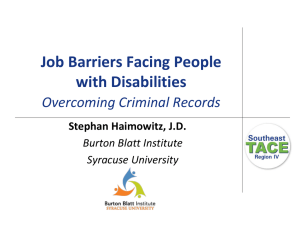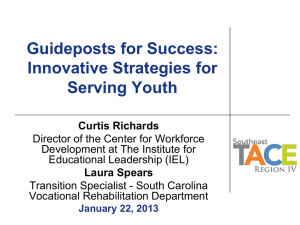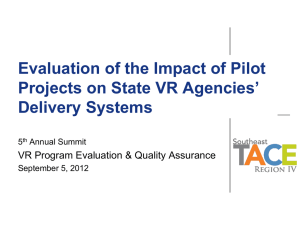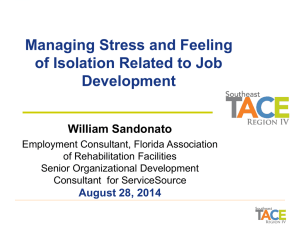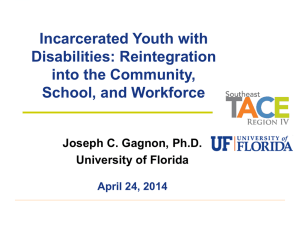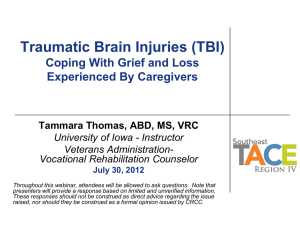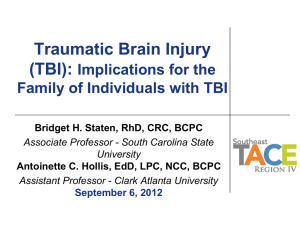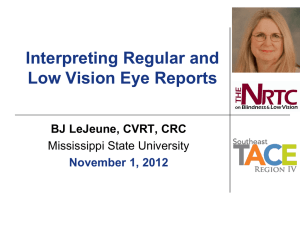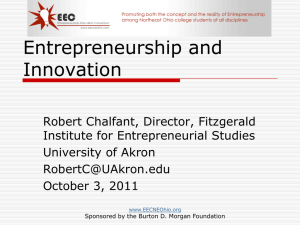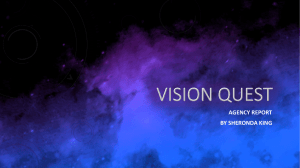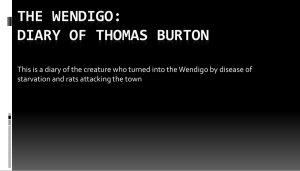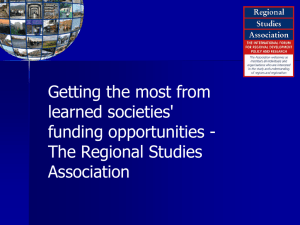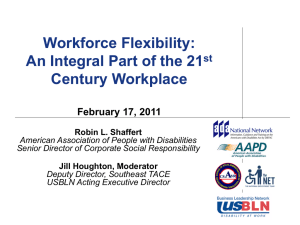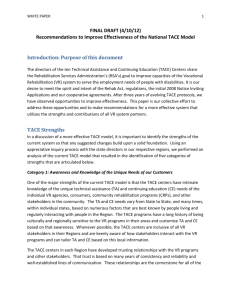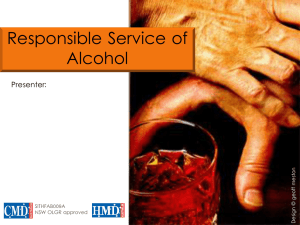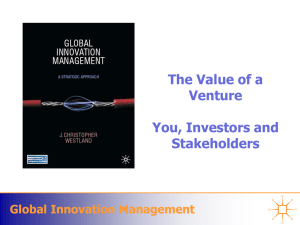PPT - Southeast TACE
advertisement
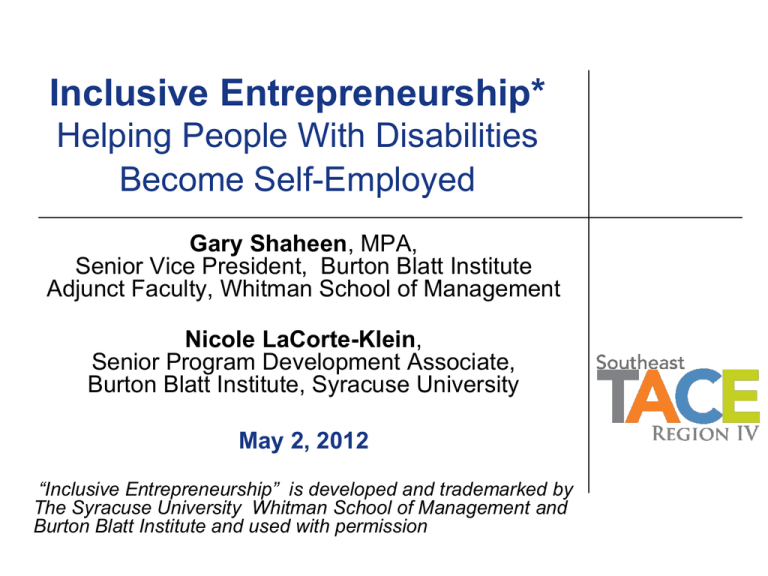
Inclusive Entrepreneurship* Helping People With Disabilities Become Self-Employed Gary Shaheen, MPA, Senior Vice President, Burton Blatt Institute Adjunct Faculty, Whitman School of Management Nicole LaCorte-Klein, Senior Program Development Associate, Burton Blatt Institute, Syracuse University May 2, 2012 “Inclusive Entrepreneurship” is developed and trademarked by The Syracuse University Whitman School of Management and Burton Blatt Institute and used with permission 2 Overview • • • • • • • • • Self-employment and VR Overview of NYMWP Entrepreneurship Projects StartUP NY #1 & #2 -Overview and Results Achieved Core Principles and Concepts: Inclusive Entrepreneurship Exercises – Stage I Partners – Who do you need and why? Outcome Milestones and Indicators Replication and Sustainability Discussion, Q&A, Next Steps TACE Center: Region IV, a project of the Burton Blatt Institute. Funded by RSA Grant # H264A080021. © 2012 3 Self-Employment as a Vocational Rehabilitation Outcome There are two sections of the Rehabilitation Act, as amended in 1998, where self-employment, telecommuting, and establishing a small business are cited as appropriate employment outcomes. • The first instance is at §7(11)(C), under the definition of an employment outcome: The term “employment outcome” means, with respect to an individual-- … (C) satisfying any other vocational outcome the Secretary may determine to be appropriate (including satisfying the vocational outcome of self-employment, telecommuting, or business ownership), in a manner consistent with the Act. TACE Center: Region IV, a project of the Burton Blatt Institute. Funded by RSA Grant # H264A080021. © 2012 4 Self-Employment as a Vocational Rehabilitation Outcome cont. The second instance is at §103(a)(13), among the vocational services to be provided under the Act: • (13) technical assistance and other consultation services to conduct market analyses, develop business plans, and otherwise provide resources, to the extent such resources are authorized to be provided through the statewide workforce investment system, to eligible individuals who are pursuing self-employment or telecommuting or establishing a small business operation as an employment outcome. TACE Center: Region IV, a project of the Burton Blatt Institute. Funded by RSA Grant # H264A080021. © 2012 5 Vocational Rehabilitation Support for Self-Employment • It is a generally underutilized option based upon OSERS Annual Review Reports for fiscal years 2003, 2005, 2006, 2007 & 2008. • http://www.start-upusa.biz/resources/state_policies/vr.cfm • VR agencies can allocate financial resources to help people with disabilities finance business costs if it is consistent with their rehabilitation plan • VR agencies can also provide loan guarantees to small businesses owned by people with disabilities (RSA-TAC00-02- July 24, 2000) TACE Center: Region IV, a project of the Burton Blatt Institute. Funded by RSA Grant # H264A080021. © 2012 6 “Inclusive EntrepreneurshipsTM” A strategy and process for assisting people with diverse disabilities to become entrepreneurs through: • Business planning training • Use of customized business development goal and support planning • Access to financial resources • Utilizing the resources of diverse public and private partners working within a consensus-driven collaborative framework Syracuse University Burton Blatt Institute/Whitman School of Management 2009 TACE Center: Region IV, a project of the Burton Blatt Institute. Funded by RSA Grant # H264A080021. © 2012 7 “Who are Entrepreneurs? “Entrepreneurs are innovative, opportunityoriented, resourceful, value-creating change agents” Dees, Economy, 2001 TACE Center: Region IV, a project of the Burton Blatt Institute. Funded by RSA Grant # H264A080021. © 2012 8 Why Entrepreneurships For People With Disabilities? More Americans are turning to self-employment as their career option and over 10 million Americans are self-employed. Entrepreneurship might be a viable career option many people with disabilities because: Choice: Many value a career as a small business owner over wage employment Capability: Many have operated, or have worked in and gained the skills needed to start a small business Control: Many want a career where they are the person in control Change: From the role of “client” or “consumer” to small business owner TACE Center: Region IV, a project of the Burton Blatt Institute. Funded by RSA Grant # H264A080021. © 2012 What Issues Are We Trying To Address Through Inclusive Entrepreneurship? 9 • High unemployment among people with disabilities• • • • • • • estimated at 65%-90% Chronic poverty Learned helplessness Stigma and misconception Services fragmentation Disincentives to work Support system needs Lack of prior success in wage employment TACE Center: Region IV, a project of the Burton Blatt Institute. Funded by RSA Grant # H264A080021. © 2012 9 10 START-UP NY: A 3 year Onondaga County led initiative funded by the US Department of Labor Office of Disability Employment Policy managed by Syracuse University’s Burton Blatt Institute with the Whitman School of Management and Onondaga SBDC and other partners • Purpose: test and evaluate models that help people with disabilities become self-employed • 3 year project goal: 150 people receive training & approx. 30 start their own businesses • Website: http://whitman.syr.edu/eee/startupny/home.htm TACE Center: Region IV, a project of the Burton Blatt Institute. Funded by RSA Grant # H264A080021. © 2012 11 Economic Self-Sufficiency Strategy Start-UP NY Start-UP Self-Employment Business Planning • Develop a viable business plan • Develop viable financial plan • Address personal income goals Economic SelfFinancial Literacy and Asset Development • Manage personal finances Sufficiency • EITC, Child care, other tax • • credits Skills for saving, investing, asset accumulation Tax prep resources Leverage New Resources • Individual Development Accounts • WIA training resources • Transportation vouchers • Micro-enterprise loans • State Vocational Rehab grants Work Incentives Planning • PASS • SSI/SSDI work incentives • PESS • HUD income disregards • Ongoing benefits planning TACE Center: Region IV, a project of the Burton Blatt Institute. Funded by RSA Grant # H264A080021. © 2012 12 “Inclusive Entrepreneurship/ Business Consulting” Whitman Course Number: EEE 443/643 Developed through as grant by the Syracuse University Kauffman Foundation ‘Initiative’ • Students receive coursework and coaching in: Entrepreneurship principles and practices Business planning fundamentals Working with entrepreneurs with disabilities and their service providers & support teams The consulting team process • Student teams work as consultants to StartUP entrepreneurs to deliver 4 products of value to growing and sustaining their businesses • 125 students/23 entrepreneurs (2012) TACE Center: Region IV, a project of the Burton Blatt Institute. Funded by RSA Grant # H264A080021. © 2012 13 4 Year Outcomes • • • • • • • • • • Trained 300 people with disabilities & low income individuals, Registered 70 businesses 51 business are still in operation Developed and modeled Financial Literacy Classes Linked with SSA Benefits Planning Assistance 61 IDA enrollees through Credit Union with foundation matching $$ Obtained 3 year SBDC grant (‘Prime’) to extend the process to generally low income individuals including those with disabilities Inclusive Entrepreneurship Course StartUP #2 with Hunter College and Columbia SBDC -12 enrolled since 6/10 Onondaga SBDC Manual for counselors TACE Center: Region IV, a project of the Burton Blatt Institute. Funded by RSA Grant # H264A080021. © 2012 14 Business Include… • A woman with both physical and visual impairments who • • • • recently launched an online gift card company. A young man with autism who has a furniture-making business. A husband and wife team, one who is blind and the other with a physical impairment, who will be launching a wholesale business that sells specialty bakery goods to large retailers. A grandmother who has turned her love of knitting into a business selling artisan sweaters. A father who is starting a moving business. TACE Center: Region IV, a project of the Burton Blatt Institute. Funded by RSA Grant # H264A080021. © 2012 14 15 Business Include cont.… • An artist who has developed a business renting large original landscapes to corporate offices. • A woman disabled due to domestic violence who started a non-profit women’s shelter funded through a grant. • A man with mobility impairment due to a car accident who started a disability sports program. • A Veteran who operates a lighting fixture and specialty clock business And many others…. Average monthly gross revenues: $150-$5,000 TACE Center: Region IV, a project of the Burton Blatt Institute. Funded by RSA Grant # H264A080021. © 2012 15 16 Replication and Pilot Information • Replicated StartUp New York in six additional regions throughout NYS • Gathered together Vocational Rehabilitation providers, service providers, family members and entrepreneurs to address needs of that area • Outcomes Included: EA Workgroup Run by Multiple Agencies in Ulster County Commission for the Blind and Visually Handicapped (CBVH) funding Inclusive Entrepreneurship Model in two regions CBVH expanding pilot into two additional regions by Summer 2012 TACE Center: Region IV, a project of the Burton Blatt Institute. Funded by RSA Grant # H264A080021. © 2012 17 Key Stakeholders for Replication • Disability Service Providers who believe that self employment is a viable option for the individuals they provide employment services too • State vocational rehabilitation agencies that were on board with developing sustainable partnerships • Small Business Development Centers • University Departments including Rehabilitation Counseling-training future Rehabilitation Counselors! TACE Center: Region IV, a project of the Burton Blatt Institute. Funded by RSA Grant # H264A080021. © 2012 18 Partnerships and Other Resources For individuals and for organizations you should consider what business resources and partners you need to develop, including but not limited to: • Business Planning • • • EAPs, SBDCs, Colleges/universities Financing Grants, loans, foundations, leveraged investment sources, IDAs Technical Expertise SCORE, Chambers of Commerce, Trade Associations, Assistive Technology/Accommodations DBTACs, One Stops, ILCs TACE Center: Region IV, a project of the Burton Blatt Institute. Funded by RSA Grant # H264A080021. © 2012 19 Lessons Learned • • • • • • • • Understand individual need, interest, conditions for success Understand the limitations of the VR system Gather diverse stakeholders to fill gaps Establish and support champions An informed decision NOT to start a business may be a success but may lead to a more informed wage employment choice Embed practices in existing systems with training and capacity building Market the mission Define and measure outcomes-individual; program; systems TACE Center: Region IV, a project of the Burton Blatt Institute. Funded by RSA Grant # H264A080021. © 2012 19 20 ‘4 Stage Inclusive Entrepreneurship Curriculum’ STAGE I STAGE II Entrepreneurial Awareness Nascent Entrepreneur Orientation and business concept development Self-assessment, Team Building & Discovery ‘Go/No-Go decision Market research Business concept Development Business training Networking STAGE IV STAGE III Sustained Growth Early Start UP Profitability Business planning Expansion Benefits and Financial Planning Financing/accounting TACE Center: Region IV, a project of the Burton Blatt Institute. Funded by RSA Grant # H264A080021. © 2012 21 4 Stage Outcome Indicators • • • • • • • • Clear Business Idea? Support Team? Work Incentives Planning? Networking with Mentors? Entrepreneurial Growth Strategy? Business Feasibility? Business Plan? Sustainability Plan? TACE Center: Region IV, a project of the Burton Blatt Institute. Funded by RSA Grant # H264A080021. © 2012 22 What is “Entrepreneurial Awareness” ? • EA=supported self-assessment • A personal inventory of preferences, skills and needed supports advancing an entrepreneurship goal • A ‘point in time’ snapshot that can be revisited and changed over time based upon your experiences in starting and operating your business • Different than traditional assessment-it does not begin by evaluating the business plan, but by developing a personal inventory and business feasibility TACE Center: Region IV, a project of the Burton Blatt Institute. Funded by RSA Grant # H264A080021. © 2012 23 Example: Awareness ‘Map’ Life History Experiences Dreams Skills Strengths Gifts Supports What Works What Doesn’t Plan Next Steps Gather Info Decide Possible Resources for Business Support & Accommodations Possible Business Options TACE Center: Region IV, a project of the Burton Blatt Institute. Funded by RSA Grant # H264A080021. © 2012 24 Entrepreneurial Awareness Asks Questions Like These: • Life history: Describe some events in your life that led • • • • you to choose entrepreneurship Skills, education, experience & strengths: List all that will help you become a successful entrepreneur Gifts: What personal talents will contribute to your success as an entrepreneur? What works/Doesn’t: Personal characteristics and habits that either help or hinder your success as an entrepreneur Who can Help: List those in your life that you can count on to help you as an entrepreneur – what specifically can each person do? TACE Center: Region IV, a project of the Burton Blatt Institute. Funded by RSA Grant # H264A080021. © 2012 25 Some Questions Regarding Entrepreneurship • What individual characteristics might help a person with a • • • disability become a successful entrepreneur? What gets in their way? What staff credentials or capabilities are needed to help people with disabilities become successful entrepreneurs? What funding resources are available and accessible that support: a) individual self-employment goal and resource planning; b) business training and feasibility development; c) development of a business plan; d) follow-along support TACE Center: Region IV, a project of the Burton Blatt Institute. Funded by RSA Grant # H264A080021. © 2012 26 Comparison To Present Experience • When you work with unemployed people with disabilities do • • • you ask if they are interested in self employment as well as wage employment? What assessment tools do you use now or contract for that will help you and the client decide if owning their own business is personally and economically feasible? How effective are you and your vendors now in: Helping the prospective entrepreneur develop or refine a business concept? Developing a feasible and viable business plan? Accessing and completing business training? Do you as the counselor have the knowledge, experience and enough information to assess a person’s business feasibility, viability and/or support a funding decision? TACE Center: Region IV, a project of the Burton Blatt Institute. Funded by RSA Grant # H264A080021. © 2012 27 What Do We mean By ‘Business Concept’? • Survival and growth of ventures are dependent upon • having a business concept that is clearly defined and “relatively” unique The concept is concerned with the essence of the business the value it creates the benefits it delivers to a customer. TACE Center: Region IV, a project of the Burton Blatt Institute. Funded by RSA Grant # H264A080021. © 2012 28 Key Areas to Examine in a Business Concept Include: • The basic product or service being offered • How the business makes its money (e.g., low service being • • • • • • • • offered margin/high volume) The complete product/service mix Core attributes or benefits of the product or service Packaging Sources of value being created for customers Branding Unique aspects of pricing, sales or distribution that, in effect, define the business Sources of differentiation Location TACE Center: Region IV, a project of the Burton Blatt Institute. Funded by RSA Grant # H264A080021. © 2012 29 Opportunity • Great business concepts and “quality” products still fail in • • the marketplace (or generate anemic returns), simply because there is no opportunity. Opportunity revolves around having customers, clients, users of the products or services provided. The other key component is that the customers, clients, users will pay enough in order for the business or organization to be profitable. TACE Center: Region IV, a project of the Burton Blatt Institute. Funded by RSA Grant # H264A080021. © 2012 30 Major opportunity concerns include: • • • • • • • • • • Forces creating the opportunity Key success factors to capitalize upon opportunity Definition of the target market Barriers to entry Competitor shortcomings or strengths Size and growth potential of the market Profit opportunity Fit between opportunity and concept Window of opportunity Customer loyalties to competitors and switching costs TACE Center: Region IV, a project of the Burton Blatt Institute. Funded by RSA Grant # H264A080021. © 2012 31 Example of a Deliverable and Process Deliverable 1: Discover market trends and create a competitive advantage Milestone 1: Complete a report that identifies potential growth areas that a prospective entrepreneur (or organization) can target Activities (including major questions): • Obtain Info from Interviews/date due: Who and why? • Obtain Info from Web research/date due: Where and why? • Obtain Info from Lit research/date due: What and why? • Write Comparative analysis - Are we competitive now? What gaps need to be filled to become competitive/date due? • Write Summary of major growth areas achievable (next 90 days, 180 days, 1 year) TACE Center: Region IV, a project of the Burton Blatt Institute. Funded by RSA Grant # H264A080021. © 2012 32 Recognizing and Addressing Obstacles that can Affect Business Sustainability Obstacles that affect business success can include: • Family circumstances (like change in marital status, having a child, etc) • Impact of disability • Change in living situation • Medication effects • Change in financial situation • Skills gap • Financial resource gap • Business plan-dynamic or static? • Other? TACE Center: Region IV, a project of the Burton Blatt Institute. Funded by RSA Grant # H264A080021. © 2012 33 Some Tools: Identify and Use a Support Team • Other people with disabilities that have started their own businesses • Business and financial mentors to provide businessrelated advice • Other personal counseling/support TACE Center: Region IV, a project of the Burton Blatt Institute. Funded by RSA Grant # H264A080021. © 2012 34 Exercise: ID and Rate the Partners! Who are your partners? Make a list to include, but not be limited to: Public and private partners Business development resources Business training and counseling resources Consumer advocates Financial institutions Who else??? Are they: 1) Already on Board, 2) Needed but not yet on board 3) What do/can they provide? TACE Center: Region IV, a project of the Burton Blatt Institute. Funded by RSA Grant # H264A080021. © 2012 35 Questions to Consider… You and/or your agency can begin asking the questions… • Are you interested in wage employment or owning your own business? • Have you ever spoken with anyone before about owning your own business? • What research have you (or can you) done to see if there is a market for your product? WHAT ELSE? TACE Center: Region IV, a project of the Burton Blatt Institute. Funded by RSA Grant # H264A080021. © 2012 36 Parting Thoughts… Entrepreneurship is not something you do… it is a philosophy that you bring to life. “Be the change you wish to see in the world.” M. Gandhi TACE Center: Region IV, a project of the Burton Blatt Institute. Funded by RSA Grant # H264A080021. © 2012 37 Comments & Questions TACE Center: Region IV, a project of the Burton Blatt Institute. Funded by RSA Grant # H264A080021. © 2012 38 Thanks and Good Luck! TACE Center: Region IV, a project of the Burton Blatt Institute. Funded by RSA Grant # H264A080021. © 2012 39 Contact Information Gary Shaheen Senior Vice President, Burton Blatt Institute Adjunct Faculty, Whitman School of Management Email: geshahee@syr.edu Nicole LaCorte-Klein, Senior Program Development Associate, Burton Blatt Institute, Syracuse University Email: nllacort@law.syr.edu TACE Center: Region IV, a project of the Burton Blatt Institute. Funded by RSA Grant # H264A080021. © 2012 40 Education Credits CRCC Credit - (1.5) Approved by Commission on Rehabilitation Counselor Certification (CRCC) • By May 12, 2012, participants must score 80% or better on a online Post Test and submit an online CRCC Request Form via the MyTACE Portal. My TACE Portal: TACEsoutheast.org/myportal TACE Center: Region IV, a project of the Burton Blatt Institute. Funded by RSA Grant # H264A080021. © 2012 41 Southeast TACE Region IV Toll-free: (866) 518-7750 [voice/tty] Fax: (404) 541-9002 Web: TACEsoutheast.org My TACE Portal: TACEsoutheast.org/myportal Email: tacesoutheast@law.syr.edu TACE Center: Region IV, a project of the Burton Blatt Institute. Funded by RSA Grant # H264A080021. © 2012 42 Disclaimer This presentation was developed by the TACE Center: Region IV ©2012 with funds from the U.S. Department of Education, Rehabilitation Services Administration (RSA) under the priority of Technical Assistance and Continuing Education Projects (TACE) – Grant #H264A080021. However, the contents of this presentation do not necessarily represent the policy of the RSA and you should not assume endorsement by the Federal Government [34 CFR 75.620 (b)]. TACE Center: Region IV, a project of the Burton Blatt Institute. Funded by RSA Grant # H264A080021. © 2012
